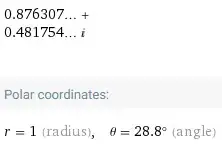If we stay strictly in the real domain, then exponentiation is defined by the formula $x^y=\exp(y\ln(x))$.
Since the logarithm is defined only on positive numbers, exponentiation is also well defined only on positive bases $x$.
With this definition $(-1)^{2.16}$ is undefined.
However, since it also comes from rational exponentiation by continuity, which is merely an extension of integer exponentiation where things like $(-1)^n$ are perfectly defined, it is possible to extend exponentiation to negative real numbers as well, but with limitation to rational exponents.
If we call $\mathbb Q_{odd}=\{\frac pq\in\mathbb Q\mid p\in\mathbb Z, q\in\mathbb N^*, \gcd(p,q)=1\text{ AND } q\text{ odd}\}$
Then for $x<0$ we have $x^r$ defined for any $r\in\mathbb Q_{odd}$ by
$$x^r=x^{\frac pq}=\sqrt[q]{x^p}=\left({\sqrt[q]{x}}\right)^p$$
Since the $q-$root is an odd function, it is perfectly defined for negative numbers.
Note that we explicitly require that $\gcd(p,q)=1$ to avoid contradictions like $-1=(-1)^{\frac 13}=(-1)^{\frac 26}=\sqrt[6]{(-1)^2}=1$
Considering this $(-1)^{2.16}=(-1)^{\frac {54}{25}}=1$ would be a reasonable answer.
Now it is also possible to take some high, and examine the situation on the complex domain.
$z_1^{z_2}=\exp(z_2\ln(z_1))$ is defined by the same formula that in the real case, but this time the logarithm has an extended definition.
The price to pay is that since $\exp$ is a $2i\pi-$periodic function, its inverse, the logarithm becomes multi-valued, meaning there will be more than one value per arithmetic expression.
We define $$\ln(z)=\ln|z|+i(\arg(z)+2k\pi)\quad k\in\mathbb Z$$
Let's examine the consequences for $(-1)^{2.16}$
$\ln(-1)=\underbrace{\ln(1)}_0+i(\underbrace{\arg(-1)}_{\pi\text{ from }e^{i\pi}=-1}+2k\pi)=(2k+1)i\pi$
Also since $2.16$ is in fact rational $\frac {54}{25}$ as we already seen, we won't get an infinite number of values for the expression, yet still $25$ different ones.
Let's call them for $k=0\cdots24$
$$z_{[k]}=\exp(\frac{54(2k+1)}{25}i\pi)=\exp(\frac{108k}{25}i\pi+\frac{54}{25}i\pi)=z_{[0]}\,\phi^k$$
With $\begin{cases}z_{[0]}=e^{(2.16i\pi)} & \text{is called the principal value at }k=0\\\phi=\exp(\frac{108}{25}i\pi) & \text{is a cyclic multiplicative factor (in this case a rotation)}\end{cases}$
As noted by Conrad, when $k=12$ then $z_{[12]}=1$ the answer found in the rational exponentiation case is effectively among the results, although it is not the principal value.
